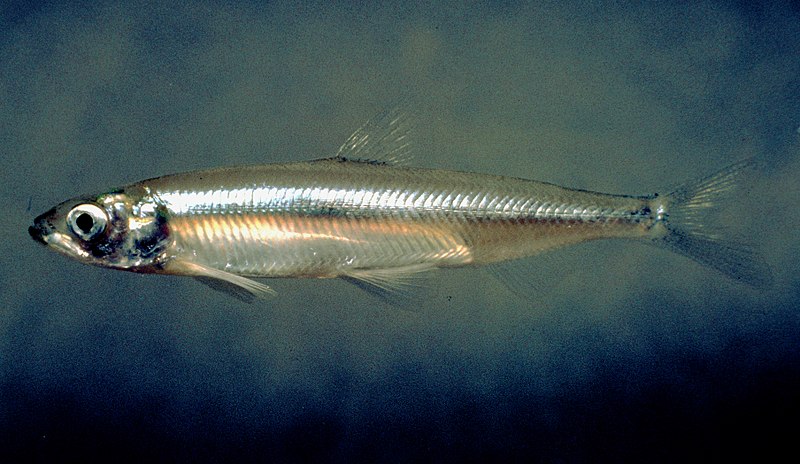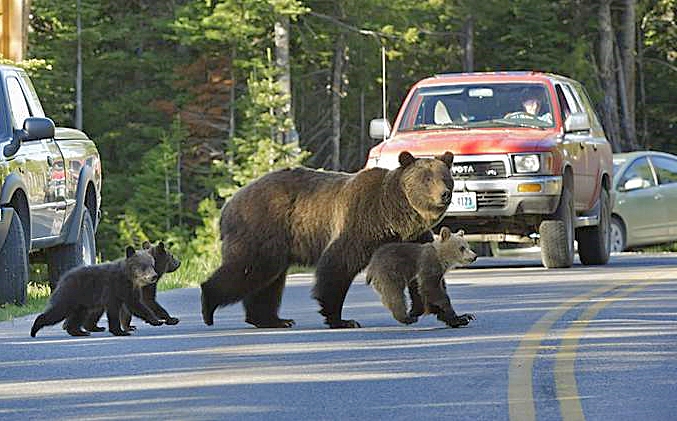The ESA directs that determinations to add or remove a species from the lists of threatened or endangered species be based solely on the best available scientific and commercial information, and these will remain the only criteria on which listing determinations will be based. The regulations retain language stating, “The Secretary shall make a [listing] determination solely on the basis of the best scientific and commercial information regarding a species’ status.”
Interior Department Press Release
Also posted by U.S. Fish & Wildlife Service
Washington – In its more than 45-year history, the Endangered Species Act (ESA) has catalyzed countless conservation partnerships that have helped recover some of America’s most treasured animals and plants from the bald eagle to the American alligator. Today, U.S. Secretary of the Interior David Bernhardt unveiled improvements to the implementing regulations of the ESA designed to increase transparency and effectiveness and bring the administration of the Act into the 21st century.
“The best way to uphold the Endangered Species Act is to do everything we can to ensure it remains effective in achieving its ultimate goal—recovery of our rarest species. The Act’s effectiveness rests on clear, consistent and efficient implementation,” said Secretary Bernhardt. “An effectively administered Act ensures more resources can go where they will do the most good: on-the-ground conservation.”
“The revisions finalized with this rulemaking fit squarely within the President’s mandate of easing the regulatory burden on the American public, without sacrificing our species’ protection and recovery goals,” said U.S. Secretary of Commerce Wilbur Ross. “These changes were subject to a robust, transparent public process, during which we received significant public input that helped us finalize these rules.”
The changes finalized today by Interior’s U.S. Fish and Wildlife Service and Commerce’s National Marine Fisheries Service apply to ESA sections 4 and 7. Section 4, among other things, deals with adding species to or removing species from the Act’s protections and designating critical habitat; section 7 covers consultations with other federal agencies.
The ESA directs that determinations to add or remove a species from the lists of threatened or endangered species be based solely on the best available scientific and commercial information, and these will remain the only criteria on which listing determinations will be based. The regulations retain language stating, “The Secretary shall make a [listing] determination solely on the basis of the best scientific and commercial information regarding a species’ status.”
The revisions to the regulations clarify that the standards for delisting and reclassification of a species consider the same five statutory factors as the listing of a species in the first place. This requirement ensures that all species proposed for delisting or reclassification receive the same careful analysis to determine whether or not they meet the statutory definitions of a threatened or endangered species as is done for determining whether to add a species to the list.
While this administration recognizes the value of critical habitat as a conservation tool, in some cases, designation of critical habitat is not prudent. Revisions to the regulations identify a non-exhaustive list of such circumstances, but this will continue to be rare exceptions.
When designating critical habitat, the regulations reinstate the requirement that areas where threatened or endangered species are present at the time of listing be evaluated first before unoccupied areas are considered. This reduces the potential for additional regulatory burden that results from a designation when species are not present in an area. In addition, the regulations impose a heightened standard for unoccupied areas to be designated as critical habitat. On top of the existing standard that the designated unoccupied habitat is essential to the conservation of the species, it must also, at the time of designation, contain one or more of the physical or biological features essential to the species’ conservation.
To ensure federal government actions are not likely to jeopardize the continued existence of listed species or destroy or adversely modify their critical habitat, federal agencies must consult with the U.S. Fish and Wildlife Service and National Marine Fisheries Service under section 7 of the Act. The revisions to the implementing regulations clarify the interagency consultation process and make it more efficient and consistent.
The revisions codify alternative consultation mechanisms that may provide greater efficiency for how ESA consultations are conducted. They also establish a deadline for informal consultations to provide greater certainty for federal agencies and applicants of timely decisions, without compromising conservation of ESA-listed species.
Revisions to the definitions of “destruction or adverse modification,” “effects of the action” and “environmental baseline” further improve the consultation process by providing clarity and consistency.
In addition to the final joint regulations, the U.S. Fish and Wildlife Service finalized a separate revision rescinding its “blanket rule” under section 4(d) of the ESA. The rule had automatically given threatened species the same protections as endangered species unless otherwise specified.
The National Marine Fisheries Service has never employed such a blanket rule, so the new regulations bring the two agencies into alignment. The change impacts only future threatened species’ listings or reclassifications from endangered to threatened status and does not apply to species already listed as threatened. The U.S. Fish and Wildlife Service will craft species-specific 4(d) rules for each future threatened species determination as deemed necessary and advisable for the conservation of the species, as has been common practice for many species listed as threatened in recent years.
From comments received during the public comment period in making these regulatory changes, concerns were raised regarding the lack of transparency in making listing decisions and the economic impact associated with determinations. Public transparency is critical in all government decision making, and the preamble to the regulation clarifies that the ESA does not prohibit agencies from collecting data that determine this cost and making that information available, as long as doing so does not influence the listing determination.
The final regulations submitted to the Federal Register can be found here: https://www.fws.gov/endangered/improving_ESA/regulation-revisions.html
Supporting comments also posted by U.S. Fish & Wildlife Service
IN CONGRESS
“The Endangered Species Act exists to identify struggling species and help them recover. Unfortunately, current implementation is drawn out and ineffective. Today’s actions will help achieve actual species recovery while providing much-needed clarity and stability to those who are too often held hostage by the ESA. I applaud Secretary Bernhardt and the Trump Administration for their continued work to make the federal government more efficient and effective, and I look forward to continue working with them to modernize the Fish and Wildlife Service.” – U.S. Senator Kevin Cramer (R-ND)
“I strongly support today’s announcement by the U.S. Fish and Wildlife Service to bring long due reforms to the Endangered Species Act. The improvements announced today will provide greater clarity to farmers, ranchers, water users and landowners in how the law is administered, yield important benefits to ecological health and ensure the efficacy of the law for years to come.” – U.S. Senator Mike Crapo (R-ID)
“This is a win for Montana and the West, and will help restore commonsense, science based decision making when it comes to the Endangered Species Act. These new rules will lead to more transparency, increased recovery of species greater conservation, and will help take the decision making powers out of the hands of radical activists in the courtroom. I applaud the administration for taking this action.” – U.S. Senator Steve Daines (R-MT)
“These revisions to the Endangered Species Act are welcome news in Idaho and across the West. The Act should be consistent and science-based, and this work by the Fish and Wildlife Service and the National Marine Fisheries Service is an encouraging step to improve the Act’s functionality for conservation, recovery, wildlife managers, and rural communities.” – U.S. Senator Jim Risch (R-ID)
“Today’s action by Secretary Bernhardt and Fish and Wildlife Service is a much needed step in the right direction for the Endangered Species Act. We’ve seen before how the Act can be abused by environmental activist agendas, but by increasing transparency and ending the practice of one-size-fits-all reactions, we can end their sue and settle tactics while promoting responsible conservation without heavy-handed government intervention.” – U.S. Senator Jim Inhofe (R-OK)
“Today’s final rules modernize Endangered Species Act regulatory requirements to improve efficiency and more closely align with the intent of Congress. Threatened and endangered species were designated as distinct classes for a reason and should function as such. With a three percent recovery rate in its nearly half century history, it is far past time that we bring the ESA into the 21st Century. I appreciate Secretary Bernhardt taking time to personally brief me on these updates. I applaud the good work of the Department of the Interior, the Fish and Wildlife Service and the National Marine Fisheries Service in strengthening the overall functionality of the Act and allowing more resources to go to truly endangered species.” – Congressional Western Caucus Chairman Paul A. Gosar (AZ-04).
“Under the previous administration, the Endangered Species Act strayed woefully far from its original intent. The Act was morphed into a political weapon instead of a tool to protect wildlife. Secretary Bernhardt’s dogged dedication to righting this wrong is again made apparent today. These final revisions are aimed at enhancing interagency cooperation, clarifying standards, and removing inappropriate one-size-fits-all practices. I look forward to supporting efforts in Congress to enshrine these revisions into law.” – Congressman Rob Bishop (UT-01)
“In Washington state, we have seen firsthand how arcane restrictions from an outdated Endangered Species Act have tied the hands of local governments and conservationists. Instead of enabling federal bureaucrats and partisan interest groups, we must focus our resources on the species that need them most. Thank you, Secretary Bernhardt, for taking this step to revise the regulations and bring the Endangered Species Act into the 21st Century.” – Congressman Dan Newhouse (WA-04)
“As the only currently-serving Member of Congress who voted for the original Endangered Species Act of 1973, I can say with great confidence that the courts have turned it into a bureaucratic nightmare that could not have been anticipated. With these new rules, the Department of the Interior is helping to reign in the ESA and bring it closer to its Congressional intent. I am pleased with Secretary Bernhardt’s announcement and will continue working with the DOI and my colleagues in Congress to ensure that the ESA is modernized and streamlined.” – Congressman Don Young (R-AK)
“While the Endangered Species Act (ESA) had great intentions when it was first enacted into law, these intentions have not met all of their original goals. The ESA has had a poor track record in delisting species and has become an overly bureaucratic process that has created divisions in the West. I applaud the Department of Interior and Secretary David Bernhardt for increasing transparency and continuing to fix this broken law.” – Congressman Russ Fulcher (ID-01)
“The Endangered Species Act’s (ESA) outdated language imposes a burden on many rural communities. Oregonians have seen how the listing of the spotted owl has forced many federal forests in Oregon into endless litigation by special interest groups that hold up forest management projects and leave communities at risk of catastrophic wildfires that choke our air with smoke and destroy the very wildlife habitat the ESA aims to protect. I am glad to see the U.S. Fish and Wildlife Service and National Marine Fisheries Service are making sensible improvements to modernize and streamline the ESA process and ensure we can protect species without overburdening our rural communities.” – Congressman Greg Walden (OR-02)
“The Trump administration is taking important steps to make the Endangered Species Act work better for people and wildlife. These final rules are a good start, but the administration is limited by an existing law that needs to be updated. I am working in the Senate to strengthen the law, so it can meet its full conservation potential. Congress needs to work across party lines to find common ground. I will continue to partner with states, stakeholders, and other senators from across the political spectrum on this important issue. We must modernize the Endangered Species Act in a way that empowers states, promotes the recovery of species, and allows local economies to thrive.” – Chairman of the Senate Committee on Environment and Public Works, Senator John Barrasso (WY)
“The Endangered Species Act was created with the good intention of protecting and conserving species on the brink of extinction. But in reality, it has inflicted more harm than good on Texas ranchers and farmers, along with the species it aims to protect. These reforms are an important step toward strengthening state and local conservation efforts, and I look forward to working with my colleagues in Congress to build on this progress by advancing the SAVES Act.” –Senator Ted Cruz (TX)
“For 45+ years, the Endangered Species Act has not fulfilled its mission and instead created burdensome red tape and unnecessary obstacles for landowners, small businesses, and communities to comply with. In Oklahoma, the American burying beetle continues to be on the endangered species list, despite a substantial increase in conservation efforts that should have removed them from the list. The ESA under the Obama Administration looked less like a preservation plan and more like blatant government overreach. I applaud the Department of Interior for taking these steps to modernize the ESA and bring the law into the 21st century.” – Congressman Markwayne Mullin (OK-02)
“I welcome the Trump Administration’s understanding of the need to modernize the Endangered Species Act. Although the law has done great things for many species, it has also become a political tool used by activist judges without any input from the American people. Therefore, I believe managing the population belongs with our state Department of Natural Resources. In northern Minnesota, the gray wolf needs to be delisted so our farmers can stop worrying about attacks on their cattle, our deer hunters can stop worrying about thinning our deer herd, and for our moose population to grow.” – Congressman Pete Stauber (MN-08)
“I continue to be encouraged that the Trump administration is actually listening to the on-the-ground advice of farmers, ranchers, and other landowners. The final rules announced today are an important step in the modernization of the Endangered Species Act, and I look forward to working with my colleagues in House of Representatives to further reform this decades-old legislation in the coming months.” – Chief Regulatory Reform Officer Andy Biggs (AZ-05)
“The ESA has been a helpful tool in protecting wildlife at risk of extinction. However, like many government programs, a lack of reform and abundance of red tape caused ESA to become ineffective and overused. These much-needed rule changes will streamline ESA regulations and allow it to fulfill its original purpose. I hope to continue working with the Interior Department and my colleagues in Congress to make positive change and steward our resources well.” – Chief Infrastructure and Forestry Officer Bruce Westerman (AR-04)
ACROSS THE COUNTRY
“The Trump Administration once again has enacted policy that respects states’ rights and adheres to the Constitution. Their updates to the Endangered Species Act establish proper thresholds and criteria that will increase regulatory efficiency and enhance the cooperative relationship between the states and the federal government.” – Louisiana Attorney General Jeff Landry
“I am thankful the Trump Administration and the Department of the Interior have recognized the need to update and streamline the most critical elements of the Endangered Species Act. By modernizing and tailoring these important functions, the Act will more effectively meet the needs and changes which have occurred over several decades. In addition, the mission and primary goals of the Act will be enhanced and improved, both for the public and for species in need of protection and recovery efforts. The Association of O&C Counties stands ready to help in every way possible with the implementation of these much-needed improvements.” – Tim Freeman, President of the Association of O&C Counties
“The final reforms to the ESA’s Section 7 Consultation requirements and regulations governing the designation of critical habitat are a positive development for landowners whose projects may impact endangered species or their designated critical habitat. These regulatory changes will streamline the cumbersome and bureaucratic permitting process and allow federal regulators to spend more time on species preservation rather than creating red tape.” – Greg Ugalde, Chairman of the National Association of Home Builders
“The ESA affects cattle-producing families across the country. We are grateful to Secretary Bernhardt and the staff at FWS and NMFS for bringing this long-awaited regulatory relief to American cattle farmers and ranchers.” – Jennifer Houston, President of the National Cattlemen’s Beef Association
“With these new rules, commonsense will once again be inserted into the ESA process. Among other things, prioritizing critical habitat designations on occupied territory, streamlining the consultation process, and rolling back the ‘Blanket 4(d) Rule’ demonstrates that the agencies are reaffirming their commitment to both conserve sensitive species and safeguard rural economies.” – Bob Skinner, President of the Public Lands Council
“We depend upon natural resources every day of our lives, and we make it a priority to conserve and protect both the land and the species that depend upon it for their habitat. We are appreciative that this administration is working with American farmers and ranchers to promote common sense values.” – Jeanette Lombardo, President of the American Agri-Women
“Our industry actively works to conserve species every day, but the current regulatory framework for the Endangered Species Act hinders landowners and companies from effectively protecting and recovering species. For far too long, the Act has been weaponized to stop the production of food, fuel, and fiber that Americans need every day while turning a blind eye to how red tape actually inhibits the recovery of species. This Administration has the fortitude to move forward with common-sense rules that follow the law while improving species protection, despite the hyperbolic rhetoric.” – Kathleen Sgamma, President of the Western Energy Alliance
“We strongly support this Administration’s efforts to modernize and improve the ESA and its implementing regulations to provide clearer direction to the agencies in applying and enforcing the law. Given the nature of water storage and delivery, Western farmers and ranchers are often directly impacted by the implementation of this federal law, which is over four decades old. The Services are taking a measured approach to assessing and making recommendations to ESA implementation. We endorse this approach, which will better serve the environment and farming and ranching families in the West.” – Dan Keppen, Executive Director for the Family Farm Alliance
Free Range Report
Thank you for reading our latest report, but before you go…
Our loyalty is to the truth and to YOU, our readers!
We respect your reading experience, and have refrained from putting up a paywall and obnoxious advertisements, which means that we get by on small donations from people like you. We’re not asking for much, but any amount that you can give goes a long way to securing a better future for the people who make America great.
[paypal_donation_button]
For as little as $1 you can support Free Range Report, and it takes only a moment.



